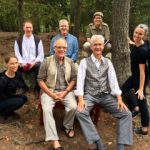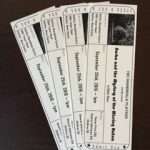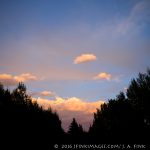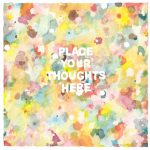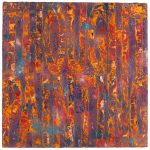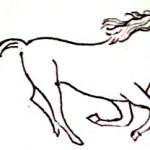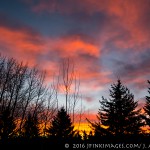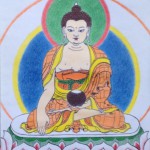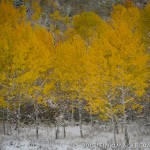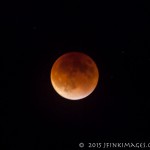Friday
Poetry by Mark Frutkin
A Word from Mark
These poems have not been published previously. They have a particular influence from my experience with meditation and the Shambhala path. I studied poetry with Allen Ginsberg when I attended Naropa Institute in Boulder, Colorado in Summer of 1976, where I also studied with other writers and heard a number of public talks by Chögyam Trungpa, Rinpoche. I have been a Buddhist meditator and a writer since the early 1970s, served as the head of the Ottawa Shambhala Centre for several years, and was appointed as the Warrior of the Centre several years ago. I have taught poetry at numerous locations: Carleton University (Ottawa), Ottawa Shambhala Centre, and Naropa Institute in Halifax. If anyone is interested in contacting me, I can be reached at [email protected]. I hope you enjoy these poems appearing in the Shambhala Times.
Without Emptiness
Without emptiness
there would exist
no spaces between fingers
or toes
leaving us with useless lumps
for hands and feet
Without emptiness
there could be no life,
for the womb
is an empty space
within each female
where life begins
Without the emptiness of space
there would be nowhere for planets
to travel or stars to move,
they would be like stones
stuck in ice,
the hunter Orion would be locked
in a cave, hibernating
with the bear known as Ursa Major
Without emptiness
nothing could happen
because there would be no space
for the poem to arise
for the lungs to breathe.
Without the emptiness of the blank page
the poem could never be written down,
without the silence in the air
the poem could never be heard.
Without emptiness
There would be no life.
Mixing Mind with Space
In meditation we say
we mix our mind with space
Blue sky
Black hole
Deep valley
Hollow mountain
Thoughtless afternoon
Dreamless sleep
Emptied drawer
Empty pocket
Car out of gas
by the side of the road
Dead horse
beside the trail
The non-number zero
A million, billion, trillion zeros
Inner ear
Outer space
Mute man
Blind woman
One minus one
One trillion minus one trillion
Blank page
Invisible ink
Leap freely
from the towering period
at the end of the poem.
Aphorism
The only way to feel
completely grounded
is to fully accept
groundlessness.
Gap
When the breath
goes out and dissolves
there’s a gap
before the next breath
is drawn in –
that gap is called
the bardo of the breath.
White Butterfly
Frantic, chaotic
the flight of the white butterfly
unstuck, unlike the leaf
stuck to its branch, its tree,
unlike the cloud pushed
in a particular direction
by prevailing winds,
unlike the stone
which moves not at all
but simply is worn away
while sinking into earth –
the white butterfly is driven,
unable to make any decision,
a bit of living trash
flicking this way and that
so like our all too
human minds.
Deep Simplicity
In Deep Simplicity
simply breathe.
Breathing in
is the world breathing out,
breathing out is the world
breathing in.
It’s that simple.
The Space that Allows
Sky is simply the space that allows
the arising and passing
of sun, moon, stars,
clouds, all celestial phenomena,
comets, lightning
and the flight of crows,
starlings and eagles,
sky is the space that allows
Eternity is the space that allows
all times: seconds, minutes, hours,
days, weeks, months,
years, lifetimes, centuries
and millennia,
eternity is the space
that allows time
Silence is the space that allows
sound: words in conversation,
songs, trill of warbler,
caw of crow,
crash, lightning, shouts,
wash of sea, trickle of creek,
silence is the space
that allows sound
The human body is the space that allows:
the empty stomach makes room
for the food to sustain life,
the empty mind
allows clarity, imagination
and the arising of new ideas,
the womb is the space that allows
the fertilized egg to grow
into new life
And finally, love is the space that allows
all emotion,
the wide-open heart that accepts
anger, joy, depression,
reconciliation, relief,
elation, happiness,
sadness, patience and empathy,
love is the space
that allows all emotion.
***
Mark Frutkin lives in Ottawa and has published 19 books, including fiction, non-fiction, and four collections of poetry, in Canada, the US, Britain, and in seven foreign translations.
His 2006 novel, Fabrizio’s Return (Knopf), won the Trillium Award and the Sunburst Award, and was a finalist for the Commonwealth Book Prize (Canada/Caribbean). His novel, Atmospheres Apollinaire (Porcupine’s Quill) was a finalist for the GG award for fiction. And finally, two of his collections of poetry have been finalists for the Ottawa Book Award. Further information on his books can be found on his website at www.markfrutkin.com
Mark came to Canada (his mother’s birthplace) as a draft resister in 1970 during the Vietnam War and lived for nine years in western Quebec in a log cabin with no electricity and no running water. Having grown up in Cleveland, Ohio and attended Loyola University in Chicago, his unusual experiences in the Canadian bush sparked his interest in poetry and it was in the cabin where he first started writing. He hopes you enjoy his work.
Entries filed under Arts and Poetry
Celebrating the Arts – HIGHLIGHT
Naming and sharing the art that inspires you on the path by Carol Henderson As I drove to work one morning this week, fall colors in the woods on either side, and a silver glimmer bright on the lake beyond, I did what I often do behind the ... continuePosted November 2, 2016 by CGH
The Play Itself to See – HIGHLIGHT
A theatrical featurette of the play Norbu and the Mystery of the Missing Ratna by Walker Blaine As noted in the earlier article “Interview with a Shambhala Playwright,” this play was performed in Halifax as part of the Harvest of Peace celebration. Shambhala centers had the option of ... continuePosted October 1, 2016 by CGH
Interview with a Shambhala Playwright – HIGHLIGHT
This Harvest of Peace weekend, a new Shambhala play, Norbu and the Mystery of the Missing Ratna, will premier at the Halifax Shambhala Centre and a theatrical featurette about the play is being made available to all local Shambhala centres for the Harvest of Peace celebrations. ... continuePosted September 21, 2016 by CGH
Poetry Space, Fall 2016 – a New Prompt, “Into Winter…” – HIGHLIGHT
As we head into late fall and soon the early days of winter, we’re delighted to feature two poems from a poet new to Poetry Space, Sydney Solis from Boulder. As the days shorten, we are increasingly eager to review new work. This time, we’re offering a ... continuePosted September 3, 2016 by
First Thought, Best Thought – HIGHLIGHT
Sometimes interesting coincidences happen…. by Michelle Welch I was browsing the Phoenix Shambhala Twitter feed and came across this photo posting from Lion’s Roar: The photographer included this comment: “In this monochromatic moment, as birds take flight, dark lines dissolve into textures. It’s a rich example of fresh seeing.” continuePosted June 23, 2016 by CGH
Writing with Beginner’s Mind – HIGHLIGHT
Writing is for everyone! A writer and workshop leader shows us how…. by Tunde Nemeth Forget everything you’ve ever learned about writing, everything you know about making an outline and following it and sticking to one point per paragraph. Forget about grammar and punctuation and making sense. Forget ... continuePosted June 21, 2016 by CGH
Place Your Thoughts Here, Part II – HIGHLIGHT
The second of two excerpts from Shambhalian Steven Saitzyk’s new dharma art book by Steven Saitzyk Place Your Thoughts Here (Version 2), by Steven Saitzyk “Just be here now.” This is advice many of us have heard. Intuitively, we know our landing place has everything to do with being ... continuePosted June 13, 2016 by CGH
Place Your Thoughts Here, Part I – HIGHLIGHT
The first of two excerpts from Shambhalian Steven Saitzyk’s new dharma art book. by Steven Saitzyk Things are not difficult to make; what is difficult is putting ourselves in the state of mind to make them. ~ Constantin Brancusi “My creative process is a meditation.” I have heard this statement often. ... continuePosted June 12, 2016 by CGH
Poetry Space – Summer 2016 – HIGHLIGHT
It’s spring moving into summer, retreat time in the Shambhala kingdom. This month, we’re delighted to welcome two poets new to Poetry Space. By the way, we’re always reviewing new submissions, so please send us yours! (Previously unpublished work only, please…) continuePosted June 7, 2016 by
Piercing the Heart of Mara – HIGHLIGHT
A poem by Jampa Pawo, dedicated to his dharma friend Grace Bull’s Eye: An Arrow Piercing the Heart of Mara Listen, brave warrior of Shambhala. In your battle against the delusions, Raise the longbow of unborn shunyata In your left hand of primordial wisdom And draw the arrow of bodhichitta With your right ... continuePosted April 28, 2016 by CGH
Windhorse Poem from Jampa Pawo – HIGHLIGHT
Kyango Karkar: The Windhorse Song poem and drawing by Jampa Pawo 2.28.16 To Kyango Karkar, the supreme windhorse, I offer this praise and invocation. Blessed by the smoke of juniper incense, Appear and grant us your inspiration! Your eyes beam a rainbow of five colors. Your perky ears resemble Bodhi leaves. Your pink tongue shines ... continuePosted April 16, 2016 by CGH
Poetry Space — Spring 2016 – HIGHLIGHT
After a couple of special projects, we’re delighted to return to publishing work that’s been submitted by the readers of Poetry Space. This also means that we’re back in the business of soliciting new work. If you submitted to Poetry Space over the winter, your submissions ... continuePosted April 14, 2016 by
Poetry Space- Shambhala Day Poetry Contest Special Edition – HIGHLIGHT
The theme of this year’s Shambhala Day poetry contest was The Shambhala Lineage manifesting in the world today, and we received many entries from around the world, each a unique expression of the theme. But one entry touched us all deeply, so deeply that despite the ... continuePosted March 17, 2016 by
2016 Shambhala Day Poetry Contest – HIGHLIGHT
This is the third year that Poetry Space has had the privilege of coordinating the annual Shambhala Day Poetry Contest. Sadly, it’s also the first time that we blew it, failing to get the winning entry to the Office of the Sakyong in time for inclusion ... continuePosted February 20, 2016 by
Blood Moon Doha – HIGHLIGHT
COLUMN: Poetry Space curated by the Shambhala Times Poetry Space Editorial Board led by Jeff Fink While we’re finishing up a forthcoming piece of reader submissions, here’s an unusual entry. Last fall, we hosted a Level 2 Shambhala training here in Salt Lake led by Shelley Pierce of Seattle. ... continuePosted January 20, 2016 by CGH
![]() RSS feed for the Arts and Poetry category
RSS feed for the Arts and Poetry category
View all posts from authors in Arts and Poetry: jillian_johnson




